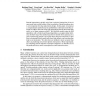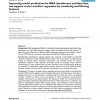508 search results - page 54 / 102 » A graphical model for protein secondary structure prediction |
ISMB
1994
13 years 10 months ago
1994
Weconsider the problem of parsing a sequence into different classes of subsequences.Twocommonexamplesare finding the exons and introns in genomicsequences and identifying the seco...
NIPS
2004
13 years 10 months ago
2004
Protein interactions typically arise from a physical interaction of one or more small sites on the surface of the two proteins. Identifying these sites is very important for drug ...
BMCBI
2010
13 years 9 months ago
2010
Background: It is well known that most of the binding free energy of protein interaction is contributed by a few key hot spot residues. These residues are crucial for understandin...
BMCBI
2007
13 years 9 months ago
2007
Background: Most methods for predicting functional sites in protein 3D structures, rely on information on related proteins and cannot be applied to proteins with no known relative...
BMCBI
2007
13 years 9 months ago
2007
Background: RNA interference (RNAi) is a naturally occurring phenomenon that results in the suppression of a target RNA sequence utilizing a variety of possible methods and pathwa...


